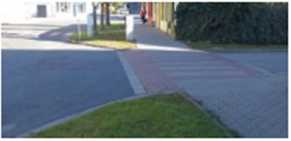9220598006
CMbiiO/
Central MeetBike
Fact Sheet H-07 - Traffic Calming Measures
Objectives of traffic calming
Traffic calming mcludes a vanety of useful measures for providing better conditions for safe cycling in the secon-dary road network. The mam goal of traffic calming is the reduction of motor vehicie volumes and speeds. Low car volumes and speeds also directly contri-bute to an increase in quality of life and a decrease in crashes on those roads.
As cities began implementing traffic calming measures. these were often part of extensive construction works leading to a modification of the road network. However. over the years bud-get limitations have madę it necessary for cities to choose between traffic calming measures in the secondary road network and improvements in the main road network. Speed 30 zones proved to be a cost-effective means of ensu-ring driver compliance with the speed limit while reguiring few modifications to the streets.
In areas where motorised traffic is concentrated on urban arterials and main roads. a large portion of a citys Street network (about 80%) will have relatively low traffic volumes. It is re-commended that the secondary road network be operated differently than main roads and arterials in order to limit exposure of local residents to negative impacts of car traffic such as crashes. noise and emissions. Speed 30 should be implemented as the standard speed limit of the secondary road network.
To achieve compliance. however. this should be reinforced with other traffic calming measures that help make the situation elear to road users. Traffic calming measures can be divided into two categories: extensive measures. that aim to reduce speed over a wide area. and isolated measures. that serve to lo-wer speeds at one particular point.
Extensive measures
Extensive traffic calming measures aim to reduce speed over a large urban area. The most common form of exten-sive traffic calming is speed 30 zones.
By reducing the speed differential between cyclists and motorists. a speed limit of 30 knvh makes a Street much morę suitable for cycling. Therefore the implementation of speed 30 zones in the secondary road network easily creates good conditions for cycling on 80-90% of a city s total road network. Additionally speed 30 improves the generał quality of life and reduces hsk of severe crashes in streets where it was implemented and accepted by drivers.
Intersections in speed 30 zones should not have a priority direction (right before left rule). Noticeability of junctions and visibility between road users should be ensured by keepmg junctions free of parked cars.
Merely posting a sign for 30 km/h might not be enough in all parts of the secondary network. sińce Street design (e.g. very wide lanes) might not proper-ly encourage drivers to drive the speed limit. Therefore additional, isolated measures might be required to ensure that speed limits are observed.
Isolated measures
It is crucial to properly design entrances to speed reduced zones in order to signify to drivers that they are lea-ving the urban main network. These entrances should clarify the changing traffic rules. Even though the sign dis-playing “Speed 30 zonę" already si-gmfies that the speed limit rs 30 knvh and intersections do not have a priority direction. experiences from Germany indicate that it is useful to underscore the change in rules. Entry treatments. consisting of elevated crossings and gateways. increase drivers- understan-ding that they are leaving the priority road network and entenng a traffic-calmed. residential area. In addition. these elements are effective measures for improving road safety at entrances to residential areas:
• Eleyated aossinos (figurę 1) raise the camageway to the same height as the adjacent sidewalk in order to high-light intersections and their right of way

Fi9ure 1. Oevated cros&ng *\ unerstó HradiStć (Jan Schubert)

Wyszukiwarka
Podobne podstrony:
CMbiiO/ Central MeetBikeFact SHEET H-09 - SlGNPOSTING AND Service Infrastructure Service stations Se
CMbii^Central MeetBikelFact Sheet H-06 - Rural Cycling (daily and leisure routes) Necessity of rural
ZmbiH Central MeetBike AFact Sheet H-08 - Bicycle Parking Facilities Introduction Ouality bicycle pa
SCMbtice/ Central MeetBike A Fact SheetH-03 - Cycling Facilities off the RoadApplication of cycle
FactSheetT-01 -Incorporate Cycling into City Administration Introduction In Central MeetBike it beca
00362 ?925c9a2744b1032ec4f0949c79ed90 366 Obenchain poor-quality, or a measure of customer/regulato
65. C.63817 THE EASTERN Caribbean Central Bank : challenges to an effective lender
ASTM (2004b). Standard test method for laboratory measurement of impact sound transmission through t
109 R1KEN Accel Próg. Rep. 24 (1990)IH-5-13. Field Measurements of the SMART Magnets Y. Tajima, K. H
160 RIKEN Accel. Próg. Rep. 24 (1990)V-2-12. Measurement of a 508 MHz Model Coupler forthe SPring-8
47 RIKEN Accel. Próg. Rep. 24 (1990)IH-2-14. Angular Distribution Measurement of K-X Rays Emittedfro
SCAN0032 Vergence • Vergence is the measure of convergence or divergence of a
SCAN0032 Vergence • Vergence is the measure of convergence or divergence of a
finalB 07 30. Which pattem of antigens is characteristic for leukemie cells in B-CLL? a) CD10+/CD19+
Figurę 2. Measurement of concavity/convexity of square or rectanguiar hollow sections Dwiatlon from
Lab 4 Measurements of digital and analog signals. Research of analog measurement and executive chann
więcej podobnych podstron